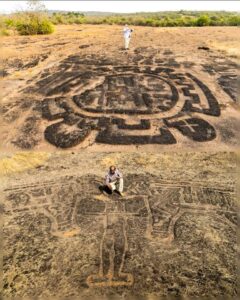The Konkan region, a coastal stretch in western India along the Arabian Sea, is renowned not only for its natural beauty but also for its rich cultural history. This area is home to some of the most fascinating and ancient rock art, which offers a rare window into the lives, beliefs, and practices of early human societies in India. Spread across Maharashtra, particularly in the districts of Ratnagiri and Sindhudurg, these petroglyphs may date back as far as 10,000 years, making them a treasure trove for researchers, historians, and art enthusiasts alike.
The Significance of the Konkan Petroglyphs
The petroglyphs of Konkan are not merely artistic expressions; they represent the early humans’ attempts to communicate with the world around them, documenting their environment, beliefs, and daily activities. The carvings are etched into rocks, with intricate depictions of animals, humans, and abstract geometric patterns. These carvings are thought to be a form of symbolic language, conveying both spiritual and practical messages for the community.

Depicting the Natural World: Animals and the Environment
One of the most striking features of Konkan rock art is the depiction of various animals. Elephants, tigers, and other wildlife are prominently featured, reflecting the natural surroundings of the early inhabitants. These animals, which were likely revered and seen as powerful symbols in their respective cultures, might have been used to depict the relationship between humans and nature, as well as to showcase the importance of hunting in early human survival. Some scholars even suggest that these carvings were part of ancient rituals or were meant to invoke the spirits of these creatures.
Geometric Patterns and Human Figures: An Insight into Early Beliefs
The petroglyphs also include numerous geometric patterns and human figures. The geometric designs are thought to represent the symbolic understanding of the cosmos and the universe, offering insight into how early humans might have perceived their place in the world. The human figures, often depicted in dynamic poses, are believed to be representations of community members, hunters, or perhaps even gods. These figures could symbolize the role of the individual within the larger social and spiritual context, providing an early visual record of human life, interaction, and belief systems.

The Role of Rituals and Mythology
Beyond animals and humans, some of the petroglyphs may depict ritualistic and mythical themes. Early civilizations often relied on art to record their myths and legends, and these carvings likely served a similar purpose. Some carvings show scenes of hunting and offerings, possibly related to fertility rites or religious practices. Others may represent mythical beings or creatures, suggesting a connection to the spiritual world and the importance of the unseen forces in everyday life. The discovery of such images provides a fascinating glimpse into the early worldview of the people of Konkan, where the lines between the natural and supernatural were often blurred.
The Cultural and Historical Impact
The significance of these rock carvings extends far beyond their artistic value. The Konkan petroglyphs are an invaluable record of the early human experience in India, shedding light on the cultures that inhabited the region long before recorded history began. They are essential for understanding the development of human art, religion, and social organization in the Indian subcontinent.
Furthermore, the study of these ancient artworks plays a crucial role in the broader field of anthropology and archaeology. By examining these petroglyphs, researchers can uncover more about the region’s ancient civilizations, their daily lives, spiritual practices, and connections to other contemporary cultures. The continuity of these traditions, evidenced through art, has contributed to the rich cultural tapestry of modern-day India.

Preserving the Legacy of Konkan Rock Art
While these rock engravings are a remarkable testament to early human culture, they are also under threat from natural weathering and human encroachment. Protecting and preserving these ancient artworks is crucial to maintaining a link to India’s prehistoric past. Ongoing efforts by archaeologists and local communities aim to safeguard these treasures for future generations to appreciate and study.
Conclusion
The rock art of Konkan serves as a powerful reminder of humanity’s deep-rooted connection to the land and its environment. Through these ancient carvings, we gain a rare glimpse into the lives of early humans, their beliefs, and the world they inhabited. The petroglyphs of Konkan are not only an artistic marvel but also a key to unlocking the mysteries of India’s ancient past, making them an indispensable part of our shared heritage. As we continue to uncover and protect these remarkable artworks, we ensure that the voices of the past are not lost to time, offering future generations a deeper understanding of our collective history.
